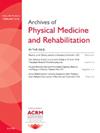Evaluating Hand Motor Coordination of Chronic Stroke Survivors Through the Combination of Features Extracted From a High-density EMG Sleeve 4361
IF 3.6
2区 医学
Q1 REHABILITATION
Archives of physical medicine and rehabilitation
Pub Date : 2025-04-01
DOI:10.1016/j.apmr.2025.01.037
引用次数: 0
Abstract
Objectives
To investigate whether hand motor coordination of stroke survivors can be explained through a combination of features extracted from a high-density electromyography (HD-EMG) sleeve.
Design
Standardized clinical assessments were evaluated in participants with stroke and scored by a licensed occupational therapist. Assessments included the upper extremity section of the Fugl-Meyer and the Modified Ashworth Scale test to assess finger and wrist spasticity. After clinical assessments, subjects performed 12 functional hand and wrist movements while HD-EMG was recorded using a wearable sleeve. Movements were visually evaluated based on an observed movement score (0=no movement, 1=visible movement, 2=incomplete movement, and 3=normal movement). After data collection, a variety of HD-EMG features, or views, were calculated from EMG, namely cocontraction, muscle correlation, muscle synergies, and motor unit firing coherence.
Setting
This study was performed at Battelle Memorial Institute.
Participants
This study enrolled able-bodied adults (n=7) and chronic stroke subjects with upper limb hemiparesis (n=7). Participants with stroke had hand impairment that interferes with their ability to perform activities of daily living and were classified as stage 1-6 on the hand subscale of the Chedoke McMaster Stroke assessment.
Interventions
Not applicable.
Main Outcome Measures
Main outcome measures include the correlation of HD-EMG features, or a combination of features, with the upper extremity section of the Fugl-Meyer and Modified Ashworth Scale scores.
Results
Stroke subjects had higher cocontraction and reduced muscle coupling when attempting to open their hand and actuate their thumb. Muscle synergies decomposed in the stroke population were relatively preserved. Alterations in synergy composition demonstrated reduced coupling between digit extensors and muscles that actuate the thumb, as well as an increase in flexor activity in the stroke group. Average synergy activations during movements revealed differences in coordination, highlighting overactivation of antagonist muscles and compensatory strategies. Motor units decomposed in the stroke population had a lower firing coherence across movements, demonstrating reduced neural drive to muscles. When combining features using canonical correlation analysis, the first latent component was correlated with upper extremity section of the Fugl-Meyer hand subscore (R2=0.85). Latent component weightings revealed interpretable measures of motor coordination and muscle coupling alterations.
Conclusions
These results demonstrate the feasibility of predicting motor function through features decomposed from a wearable HD-EMG sleeve, which could be leveraged to improve stroke research and clinical care. Disclaimer: This device has not been approved or cleared as safe or effective by US Food and Drug Administration. This device is limited by US federal law to investigational use.
Disclosures
All authors are employees of Battelle Memorial Institute, which has developed the NeuroLife Sleeve.
通过高密度肌电图套筒提取的特征组合评估慢性中风幸存者的手部运动协调4361
目的探讨脑卒中幸存者的手部运动协调是否可以通过高密度肌电图(HD-EMG)套筒提取的特征组合来解释。设计对卒中患者进行标准化临床评估,并由执业职业治疗师评分。评估包括Fugl-Meyer上肢部分和改良Ashworth量表测试,以评估手指和手腕痉挛。临床评估后,受试者进行12次手部和手腕功能运动,同时使用可穿戴套筒记录HD-EMG。根据观察到的运动评分对运动进行视觉评估(0=无运动,1=可见运动,2=不完全运动,3=正常运动)。数据收集后,从肌电图中计算各种HD-EMG特征或视图,即收缩,肌肉相关性,肌肉协同作用和运动单元发射相干性。本研究在巴特尔纪念研究所进行。参与者:本研究招募了健全成人(n=7)和慢性中风上肢偏瘫患者(n=7)。中风参与者的手部损伤影响了他们进行日常生活活动的能力,他们在切多克·麦克马斯特中风评估的手部分量表中被划分为1-6级。InterventionsNot适用。主要结果测量主要结果测量包括HD-EMG特征或特征组合与Fugl-Meyer和修正Ashworth量表上肢部分评分的相关性。结果卒中受试者在试图张开手和激活拇指时,有更高的收缩和减少的肌肉耦合。脑卒中人群中分解的肌肉协同作用相对保存。协同作用组成的改变表明,在中风组,手指伸肌和驱动拇指的肌肉之间的耦合减少,以及屈肌活动的增加。运动期间的平均协同激活揭示了协调的差异,突出了拮抗剂肌肉和代偿策略的过度激活。中风人群中分解的运动单元在运动中具有较低的发射一致性,表明神经对肌肉的驱动减弱。当使用典型相关分析组合特征时,第一潜在成分与Fugl-Meyer手亚评分上肢部分相关(R2=0.85)。潜在成分权重揭示了运动协调和肌肉耦合改变的可解释测量。结论通过可穿戴式HD-EMG套分解的特征预测运动功能的可行性,可用于提高脑卒中研究和临床护理水平。免责声明:本设备尚未被美国食品和药物管理局批准为安全或有效。该装置受美国联邦法律限制,只能用于调查。所有作者都是巴特尔纪念研究所的员工,该研究所开发了神经生命袖。
本文章由计算机程序翻译,如有差异,请以英文原文为准。
求助全文
约1分钟内获得全文
求助全文
来源期刊
CiteScore
6.20
自引率
4.70%
发文量
495
审稿时长
38 days
期刊介绍:
The Archives of Physical Medicine and Rehabilitation publishes original, peer-reviewed research and clinical reports on important trends and developments in physical medicine and rehabilitation and related fields. This international journal brings researchers and clinicians authoritative information on the therapeutic utilization of physical, behavioral and pharmaceutical agents in providing comprehensive care for individuals with chronic illness and disabilities.
Archives began publication in 1920, publishes monthly, and is the official journal of the American Congress of Rehabilitation Medicine. Its papers are cited more often than any other rehabilitation journal.

 求助内容:
求助内容: 应助结果提醒方式:
应助结果提醒方式:


